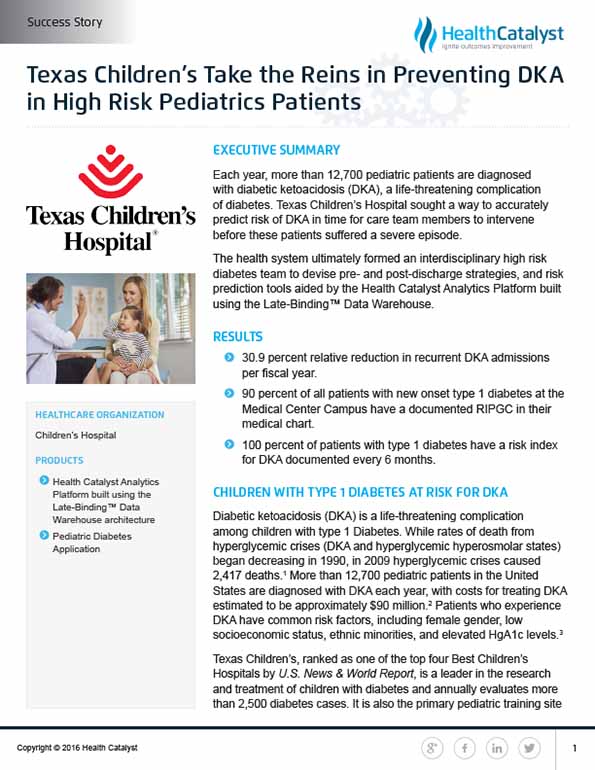To better serve its pediatric patients, Texas Children's Hospital created a multidisciplinary high-risk diabetes team to develop strategies for predicting and preventing diabetic ketoacidosis (DKA) episodes. The organization utilized risk prediction tools powered by the Health Catalyst Analytics Platform and a Late-Binding™ Data Warehouse to support the team's efforts.
Each year, more than 12,700 pediatric patients are diagnosed with diabetic ketoacidosis (DKA), a life threatening complication of diabetes. Texas Children’s Hospital sought a way to accurately predict risk of DKA in time for care team members to intervene before these patients suffered a severe episode.
The health system ultimately formed a interdisciplinary high risk diabetes team to devise pre- and post-discharge strategies, and risk prediction tools aided by the Health Catalyst Analytics Platform built using the Late-Binding™ Data Warehouse.
Diabetic ketoacidosis (DKA) is a life-threatening complication among children with type 1 Diabetes. While rates of death from hyperglycemic crises (DKA and hyperglycemic hyperosmolar states) began decreasing in 1990, in 2009 hyperglycemic crises caused 2,417 deaths.1 More than 12,700 pediatric patients in the United States are diagnosed with DKA each year, with costs for treating DKA estimated to be approximately $90 million.2 Patients who experience DKA have common risk factors, including female gender, low socioeconomic status, ethnic minorities, and elevated HgA1c levels.3
Texas Children’s, ranked as one of the top four Best Children’s Hospitals by U.S. News & World Report, is a leader in the research and treatment of children with diabetes and annually evaluates more than 2,500 diabetes cases. It is also the primary pediatric training site for Baylor College of Medicine. This noted provider in children’s health was determined to make a significant reduction in complications arising from diabetes in our most vulnerable populations.
While Texas Children’s has invested in the development of a clinic model that closely supports patients with diabetes, there was often the sense that a critical piece was missing, particularly for patients with challenging socioeconomic circumstances or psychological difficulties, such as anxiety, depression, or low-self-esteem. Often, these children and their families would not be identified until the child was admitted to the hospital for DKA, or when their HgbA1c, a key measure of glucose control over time, was over 11 percent. Far from the recommended values of less than 7.5 percent.
Texas Children’s had a simple but sweeping mission: assure that all of its highest risk patients with type 1 diabetes received the type of supportive care they needed. To achieve this, it needed a way to identify who these highest-risk patients were. But, while social and psychological factors were documented in the EHR, these were difficult to find, typically embedded in notes or documented in disparate places. As such, Texas Children’s needed a solution that could overcome these drawbacks to utilize psychosocial risk factors to accurately predict risk for DKA.
Texas Children’s ultimately formed a High Risk Care Process Team (CPT), integrated within the larger Diabetes CPT. This interdisciplinary body of experts includes certified diabetic educators, social workers, endocrinologists and psychologists, and data analysts. Aided by predictive analytics, they are turning out to be a remarkably effective force in addressing the risk factors that lead to DKA.
This was prefaced by a determination to address variation, provide comprehensive outpatient follow up, and most critically, put plans in place to help vulnerable children from being hospitalized at all. The team also understood any quality improvement efforts should be measured, which requires data and analytics. To measure the effectiveness of its own work, the High Risk CPT established measurable, specific, time-bound goals. These included:
Developing a predictive risk model for DKA. In need of a mechanism to predict patient risk for DKA, the team turned to foundational work earlier created by physicians at Baylor College of Medicine. The Baylor clinicians had developed and validated a psychosocial risk index for poor glycemic control (RIPGC) for children newly diagnosed with Type 1 Diabetes.4 This tool accurately discriminates between children with and without high risk of poor glycemic control and DKA in the first year after diagnosis.
Aware that RIPGC for newly diagnosed diabetes provides valuable information for guiding diabetes care, Texas Children’s established an additional goal to document the RIPGC score for at least 90 percent of patients newly diagnosed with type 1 diabetes. The RIPGC also served as the framework for development of a risk prediction score for DKA in patients with type 1 diabetes who’ve had diabetes for longer than one year. Here the goal was to have a risk score for subsequent DKA events in the next year documented every six months.
Texas Children’s was aided in its initiative with a pediatric diabetes application, created using the Health Catalyst Analytics Platform built using the Late-Binding™ Data Warehouse architecture (EDW). The analytics platform played a key role in developing a risk index for DKA, as the team needed more than just the clinical data available in the EHR. Risk for DKA is increased by socioeconomic status, so they needed to include this data, in addition to clinical data, claims data, and the number of clinic visits in a year. The comprehensive data resources in the EDW enabled accurate scoring and automated score calculations.
Automation of the risk scoring was critical. Clinicians already had a sizeable amount of documentation to complete for each patient encounter. Adding risk score information to a flowsheet in the EHR and asking clinicians to document and calculate the risk score would never result in the consistency needed to accurately predict and manage patient risk. While development of an automated system took time because of the complexity of the data, and required analyst and data architect resources, the team made the investment in automation to ensure the reliability and availability of meaningful data for the entire care team.
With a comprehensive data set available for use, the team spent substantial time defining what it meant to be at increased risk, focusing on those patients who were at increased risk for DKA, and discussing the various factors that contribute to increased risk for DKA. Once the High Risk CPT came to agreement on the factors that contribute to increased risk, the team developed a risk stratification tool. To validate the risk score, the tool was applied retroactively to Texas Children’s own patients in the EDW. Through use of analytics and statistical controls, the team was able to narrow the selected risk factors and develop a tool that is truly predictive. The Risk Index for DKA stratifies patients into four tiers of risk: high risk, moderate risk, mild risk, and lowest risk.
Now Texas Children’s has the health risk assessment tools to identify high risk of DKA, and make informed decisions about resources, interventions, and models of care designed to proactively manage and mediate patient risk (see Figure 1).

As poor glycemic control and DKA are heavily influenced by socioeconomic factors, increased social support and a change in the approach of the medical team can further reduce rates of DKA. As such, the care team at Texas Children’s includes social workers, and a new role of a high risk social worker, who is dedicated to supporting those patients who have two or more admissions for DKA in a one-year period.
Historically, clinic team meetings with families were focused on a contract of care, which outlined the medical treatment plan patients would need to comply with in order to avoid hospitalizations. Using a different approach, the social worker and psychologist work with the interdisciplinary care team to reframe conversations with the patients and their family, focusing first on the patient’s goals and needs, while including the family in planning. This increases patient engagement, which is paramount to achieving better outcomes.
Social workers also collaborate with case managers outside of Texas Children’s. Through their use of claims data while developing the Risk Index for DKA, Texas Children’s developed a positive working relationship with Texas Children’s Health Plan. Social workers and case managers worked together to improve the referral process for case management, creating an easy path for referral for those patients admitted for DKA and those with high HgbA1c. Case workers and social workers from the two entities now routinely update one another, making sure that all involved are aware of the patient’s care plan, and improving access to care for the highest risk patients.
A recent challenging patient situation highlights the effectiveness of skilled social workers and the importance of recognizing the impact of socioeconomic and psychological factors on patient outcome. A child with diabetes was admitted to Texas Children’s for severe DKA three times during the last year. Each of the DKA episodes was severe. The child’s nutrition was severely impaired, and he had lost a significant amount of weight. It was apparent that the child’s family was not able to care for him, putting his life at risk. Historically, this type of situation may have resulted in a filing with child protective services.
In this case, the social worker was able to discover the barriers to better care for the child. The father worked several jobs, and the child’s overwhelmed aunt caretaker didn’t feel prepared to manage the child’s insulin. The social worker galvanized the necessary support, and then followed up to assure the aunt was better prepared to provide care. Subsequently, the child’s HgbA1c decreased from 11 percent to 7 percent, and the aunt was able to help the patient stabilize his nutrition and gain some much needed weight. Most importantly, the child was able to stay with the family who loved him.
Through accurate prediction of risk for DKA, skilled social workers, contributions of the interdisciplinary team, and improved patient engagement, the High-Risk CPT at Texas Children’s is improving the outcomes of patients with Type 1 Diabetes.
“We believe that our predictive analytics, with support from the high-risk social worker, is decreasing our admissions for DKA. More importantly, we are helping to improve the quality of life for our high-risk patients with diabetes.”
– Kelly Fegan-Bohm, MD, B.A., Diabetes and Endocrinology, Co-Lead High Risk CPT
Texas Children’s continues to work on reducing diabetes-related hospitalizations, particularly for DKA, and is focused on reducing the percentage of patients in the high and moderate tier of the Risk Index for DKA. The children’s hospital is also testing interventions with a high-risk pilot group. If these interventions further decrease the incidence of DKA as anticipated, they will be implemented as the standard of care across Texas Children’s.




